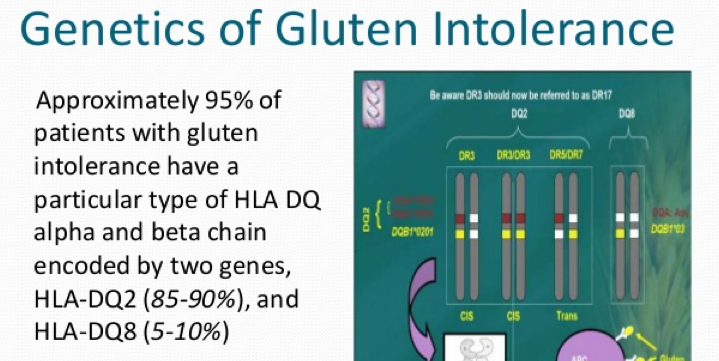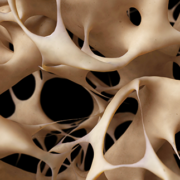Link? Celiac Disease and Amyotrophic Lateral Sclerosis?
 “Celiac disease is an autoimmune disorder triggered by gluten in genetically predisposed individuals. Gluten sensitivity induces a inflammatory reaction in the small intestine mucosa, but it can also cause neurologic manifestations, such as ataxia (impaired coordination, balance and speech), neuropathy, dizziness, epilepsy, and cortical calcifications, both with or without gastrointestinal symptoms,” observes Sara Adaes, PhD in Celiac Disease And Amyotrophic Lateral Sclerosis – Is There a Link?
“Celiac disease is an autoimmune disorder triggered by gluten in genetically predisposed individuals. Gluten sensitivity induces a inflammatory reaction in the small intestine mucosa, but it can also cause neurologic manifestations, such as ataxia (impaired coordination, balance and speech), neuropathy, dizziness, epilepsy, and cortical calcifications, both with or without gastrointestinal symptoms,” observes Sara Adaes, PhD in Celiac Disease And Amyotrophic Lateral Sclerosis – Is There a Link?
“Celiac disease is also often observed as a comorbidity of other autoimmune conditions such as
systemic lupus erythematosus, rheumatoid arthritis, or myasthenia gravis.”
Celiac Disease and ALS
In two case reports described a few years ago, patients with neurological symptoms and MRI scans showing white matter lesions in the brain were initially diagnosed with the progressive motor neuron disease amyotrophic lateral sclerosis (ALS). Upon further analysis, the patients were found to actually have celiac disease mimicking ALS. In both cases, the neurological symptoms of ALS improved with a strict gluten-free diet.
A study recently published in JAMA Neurology aimed to further explore this link between celiac disease and ALS by searching for gluten-sensitivity markers in an ALS clinical population.
 Gadoth and colleagues scanned a number of antibodies in the blood of these patients and found that 15.3% of the patients with ALS were seropositive for transglutaminase 6 antibodies, compared with only 4.3% of the controls. The patients that were seropositive for transglutaminase 6 showed a classic picture of ALS, similar to that of seronegative patients.
Gadoth and colleagues scanned a number of antibodies in the blood of these patients and found that 15.3% of the patients with ALS were seropositive for transglutaminase 6 antibodies, compared with only 4.3% of the controls. The patients that were seropositive for transglutaminase 6 showed a classic picture of ALS, similar to that of seronegative patients.
Tissue transglutaminase 6 is primarily expressed in the brain. Gluten-associated ataxia had already been linked to the presence of serum transglutaminase 6 antibodies; these had been reported to be present in 62% of patients with gluten ataxia. Other studies had also found transglutaminase 6 antibodies associated with gluten neuropathy, as well as with schizophrenia and cerebral palsy.
 Aiming at further establishing a link between ALS symptoms and celiac disease, the authors assessed the genetic profile of the ALS patients to determine if they carried the HLA genetic variants associated with celiac disease. They found that 86.4% of patients who were seropositive for transglutaminase 6 autoantibodies also carried celiac disease susceptibility HLA variants. They thereby established a direct link between celiac disease and ALS symptoms in this group of patients.
Aiming at further establishing a link between ALS symptoms and celiac disease, the authors assessed the genetic profile of the ALS patients to determine if they carried the HLA genetic variants associated with celiac disease. They found that 86.4% of patients who were seropositive for transglutaminase 6 autoantibodies also carried celiac disease susceptibility HLA variants. They thereby established a direct link between celiac disease and ALS symptoms in this group of patients.
The data from this study strengthens the hypothesis that ALS may be associated with autoimmunity and gluten sensitivity, at least in a subset of patients with celiac disease.
Although there is still need to further study and confirm this link, these results are important in the sense that gluten sensitivity is easily treatable; ALS symptoms in this subset of patients could therefore also potentially be reverted – a gluten-free diet could do the trick.
Gluten Sensitivity in Celiac Disease
The clinical hallmark of celiac disease is the presence of anti-tissue transglutaminase antibodies in the blood. Tissue transglutaminase is an enzyme that is released from cells during inflammation. Transglutaminase is considered to exert at least two critical roles in celiac disease: it can enhance the stimulatory effect of gluten on the immune system, and it can be a target for an autoimmune response.
Gluten is a protein complex made up of the proteins gliadin and glutenin. Gliadin peptides are rich in the aminoacid glutamine and are therefore excellent substrates for transglutaminase enzymatic action, which produces deamidated gliadin.
The genetic predisposition to celiac disease is associated with specific HLA antigen molecules expressed in antigen presenting cells of the immune system. A vast majority of people with celiac disease have either the HLA-DQ2 or the HLA-DQ8 variant.
Deaminated gliadin produced by transglutaminase as a higher affinity for these specific variants of HLA molecules. By being able to preferentially bind to them, deamidated gliadin produced by transglutaminase becomes more effective in triggering an autoimmune response in people with this genetic profile.
References
White matter lesions suggestive of amyotrophic lateral sclerosis attributed to celiac disease. AJNR. American journal of neuroradiology, 31 (5), 880-1 PMID: 19910450 Brown KJ, Jewells V, Herfarth H, & Castillo M (2010).
The function of tissue transglutaminase in celiac disease. Autoimmunity reviews, 11 (10), 746-53 PMID: 22326684 Di Sabatino A, Vanoli A, Giuffrida P, Luinetti O, Solcia E, & Corazza GR (2012).
Transglutaminase 6 Antibodies in the Serum of Patients With Amyotrophic Lateral Sclerosis. JAMA neurology, 72 (6), 676-81 PMID:25867286 Gadoth A, Nefussy B, Bleiberg M, Klein T, Artman I, & Drory VE (2015).
Autoantibodies in gluten ataxia recognize a novel neuronal transglutaminase. Annals of neurology, 64(3), 332-43 PMID: 18825674 Hadjivassiliou M, Aeschlimann P, Strigun A, Sanders DS, Woodroofe N, & Aeschlimann D (2008).
A case of celiac disease mimicking amyotrophic lateral sclerosis. Nature clinical practice. Neurology, 3 (10), 581-4 PMID: 17914346 Turner MR, Chohan G, Quaghebeur G, Greenhall RC, Hadjivassiliou M, & Talbot K (2007).
Motor neuron disease: Can gluten sensitivity mimic amyotrophic lateral sclerosis? Nature reviews. Neurology, 11 (6) PMID: 25917703 Wood H (2015)
Sara Adaes, PhD (c) has been a researcher in neuroscience for a decade. She studied biochemistry and did her first research studies in neuropharmacology. She has since been investigating the neurobiological mechanisms of pain and is finishing her PhD at the Faculty of Medicine of the University of Porto, in Portugal. Follow her on Twitter @saradaes













